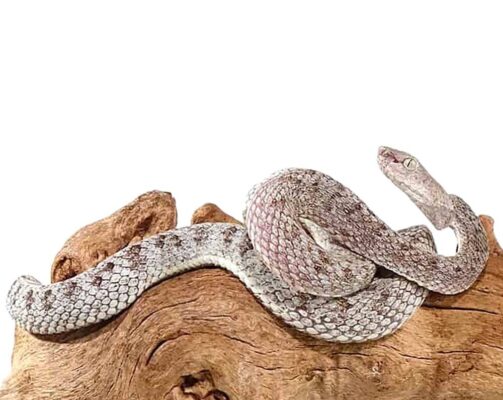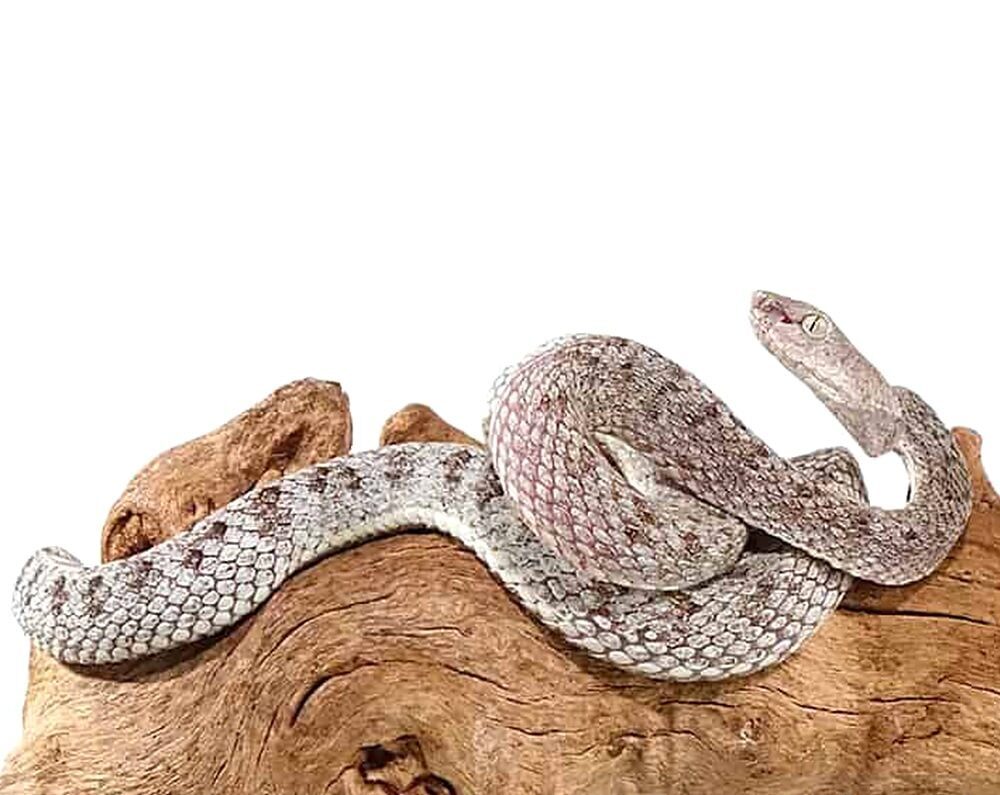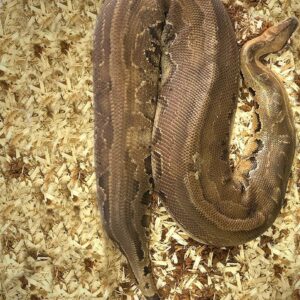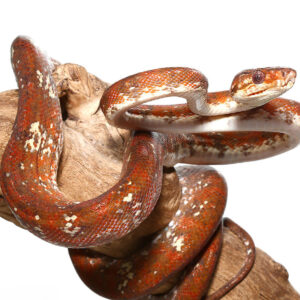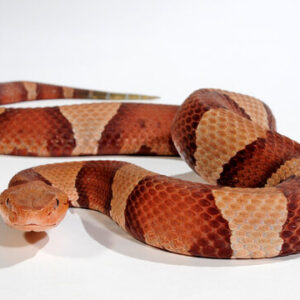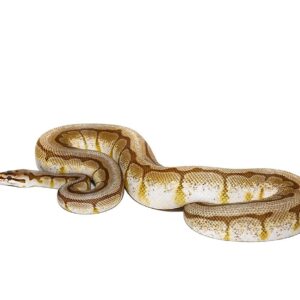McGregor Pit Viper For Sale
$999.99
WE HAVE MCGREGOR PIT VIPERS FOR SALE. HERE ARE SOME HIGHLIGHTS:
- Trimeresurus mcgregori
- Captive Bred
- 2010 Male
- Approximately 36 Inches In Length
- Adults Will Grow To About 3ft
- Extremely Variable In Color, This Specimen Looks Like Its Carved From Stone
- Feeding On Frozen Thawed Or Live Adult Mice
- *These Are Venomous. Please Know Your State Laws Before Inquiring As Some States Require Venomous Permits*
FUN FACTS!
- Native To The Philippines And Batanes Island
- Tropical Species Requiring Temperatures From The Mid 80s To Low 90s
- These Are Arboreal, Taller Set Ups With Plenty Of Branches Are A Must
Description
The McGregor Pit Viper, scientifically known as Trimeresurus mcgregori, is a species that stands out in the diverse family of pit vipers. Named after the American herpetologist Richard C. McGregor, who played a pivotal role in its discovery in the early 20th century, this viper has intrigued scientists and enthusiasts alike. The McGregor Pit Viper is also commonly referred to by its local name in the Philippines, where it predominantly resides.
This species belongs to the genus Trimeresurus, which comprises several other notable pit vipers known for their heat-sensing capabilities. These sensors, located between the eyes and nostrils, allow the snakes to detect warm-blooded prey, a feature that is particularly fascinating to researchers studying reptilian adaptations. The McGregor Pit Viper has been a subject of scientific curiosity due to its unique ecological niche and adaptive behaviors.
First identified in the early 1900s, the McGregor Pit Viper was initially discovered on Polillo Island in the Philippines. Since then, it has been the focus of numerous studies aimed at understanding its habitat preferences, feeding habits, and reproductive behaviors. The discovery of this species has not only expanded the knowledge of pit vipers but has also underscored the rich biodiversity found in the Philippine archipelago.
Studying the McGregor Pit Viper is crucial for several reasons. It provides insights into the evolutionary pathways of pit vipers and helps in understanding the ecological dynamics of the regions they inhabit. Additionally, the viper’s venom has potential applications in medical research, making it an important subject for pharmacological studies. The McGregor Pit Viper, with its distinctive characteristics and significant role in its ecosystem, offers a remarkable opportunity for scientists and conservationists to delve deeper into the complex world of reptilian life.
Physical Characteristics and Identification
The McGregor Pit Viper, scientifically known as Trimeresurus mcgregori, is a captivating species that exhibits a range of unique physical traits. Adult McGregor Pit Vipers typically measure between 60 to 80 centimeters in length, with females generally being larger than males. This species displays a robust and muscular build, allowing it to adeptly navigate its arboreal and terrestrial habitats.
One of the most striking features of the McGregor Pit Viper is its vivid coloration. The viper’s scales can range from a vibrant green to a rich olive hue, often accented by a series of dark, irregular crossbands that provide effective camouflage in its natural environment. Juveniles, on the other hand, may exhibit a more muted coloration that gradually intensifies as they mature. This gradual change in coloration serves as a key identification marker for differentiating age groups within the species.
A defining characteristic of the McGregor Pit Viper is its heat-sensing pits, located between the nostrils and eyes. These specialized sensory organs enable the viper to detect infrared radiation emitted by warm-blooded prey, facilitating hunting in low-light conditions. The presence of these pits is a crucial diagnostic feature that distinguishes the McGregor Pit Viper from other non-venomous snakes in the region.
Sexual dimorphism is evident in the McGregor Pit Viper, with females typically possessing a bulkier body structure and greater overall length compared to males. Additionally, males are often observed to have slightly longer tails, a morphological trait linked to reproductive functions. Variations within the species can also be noted in the pattern and intensity of the crossbands, which may differ based on geographic location and environmental factors.
Identifying the McGregor Pit Viper in the wild requires careful observation of these physical attributes, along with an understanding of its preferred habitats. By recognizing its distinctive coloration, heat-sensing pits, and sexual dimorphism, herpetologists and enthusiasts can accurately distinguish this fascinating viper from other serpents in its ecosystem.
Habitat and Distribution
The McGregor Pit Viper, a species that has captivated herpetologists and nature enthusiasts alike, predominantly inhabits the lush, biodiverse regions of the Philippines. This elusive snake is primarily found in the mountainous areas and forests of Luzon Island, where it thrives in the dense vegetation and cooler climates. The geographical distribution of the McGregor Pit Viper is quite restricted, making it an endemic species with a limited range.
Within these regions, the McGregor Pit Viper exhibits a marked preference for specific ecosystems. It is commonly found in montane and mossy forests, which provide an ideal environment with ample cover and abundant prey. The dense canopy and underbrush offer protection and camouflage, crucial for both hunting and avoiding predators. These forests, often situated at elevations ranging from 1000 to 2000 meters above sea level, provide the optimal conditions for the viper’s survival.
In addition to its strong association with forested areas, the McGregor Pit Viper has also been observed in secondary growth forests and occasionally in agricultural lands that border its natural habitat. This adaptability to varied environments highlights its resilience, although it is rarely found in heavily urbanized or extensively cleared regions. The viper’s preference for humid, shaded environments underscores its reliance on specific microhabitats that support its thermoregulatory and ecological needs.
Environmental preferences of the McGregor Pit Viper are influenced by several factors, including temperature, humidity, and prey availability. The species tends to avoid extreme temperatures and open, arid landscapes, favoring instead the stable, moist microclimates provided by its preferred habitats. This selective habitat use underscores the importance of conserving its natural environments, as habitat destruction poses a significant threat to its population.
Understanding the habitat and distribution of the McGregor Pit Viper is crucial for developing effective conservation strategies. Protecting the forests and mountainous regions of Luzon Island will not only safeguard this unique viper but also the myriad of other species that share its habitat.
Behavior and Ecology
The McGregor Pit Viper exhibits fascinating behavioral patterns that contribute significantly to its survival and ecological role. Primarily nocturnal, this viper tends to be most active during the night, when it hunts for its prey. The McGregor Pit Viper’s diet primarily consists of small mammals, birds, and occasionally amphibians, showcasing its adaptability in prey selection. Utilizing its highly sensitive heat-sensing pits, the viper accurately detects warm-blooded prey even in complete darkness, making it a proficient predator.
When it comes to hunting techniques, the McGregor Pit Viper employs a sit-and-wait strategy, remaining motionless and camouflaged until unsuspecting prey comes within striking distance. This ambush method is energy-efficient and highly effective, as the viper’s venom quickly immobilizes its prey. The venom not only incapacitates but also begins the digestive process, making it easier for the viper to consume its catch. In terms of interactions with other species, the McGregor Pit Viper is generally solitary, except during the mating season.
Reproductive behavior in the McGregor Pit Viper is equally intriguing. Breeding typically occurs in the warmer months, with males engaging in combat for the attention of females. These combat rituals involve intertwining their bodies and attempting to overpower one another, showcasing their strength and dominance. Once a female is successfully courted, she will give birth to live young, a trait known as ovoviviparity, where eggs develop inside the mother’s body until they hatch. The viper gives birth to a small number of offspring, which are independent from birth and receive no parental care.
The lifecycle of the McGregor Pit Viper includes several stages, from birth to adulthood. Juveniles are more vulnerable and therefore exhibit different behavioral patterns compared to adults, such as hiding more frequently and choosing smaller prey. As they grow, their hunting skills and venom potency increase, making them formidable predators within their habitat. Through these behaviors and ecological interactions, the McGregor Pit Viper plays a crucial role in maintaining the balance of its ecosystem.
Venom and Its Effects
The McGregor Pit Viper, a species known for its potent venom, presents a fascinating case study in herpetology. The venom of this viper is a complex cocktail of proteins, enzymes, and other molecules specifically evolved to immobilize and pre-digest its prey. The primary components include hemotoxins, which disrupt blood clotting and cause extensive tissue damage, and neurotoxins, which impair the nervous system, leading to paralysis. This combination makes the McGregor Pit Viper’s venom both highly effective and deadly.
For its prey, the venom acts rapidly. Hemotoxins cause internal bleeding and tissue necrosis, facilitating the digestion process even before the prey is swallowed. Neurotoxins, on the other hand, attack the nervous system, resulting in swift immobilization. The potency of the venom ensures that even small doses can be lethal to small mammals and birds, the primary diet of the McGregor Pit Viper.
When it comes to human encounters, the venom of the McGregor Pit Viper poses significant medical implications. Envenomation can result in severe pain, swelling, and tissue damage at the site of the bite. Systemic effects may include nausea, vomiting, dizziness, and difficulty breathing due to the neurotoxic components. In severe cases, kidney failure and hemorrhage can occur. Prompt medical attention is crucial, as the venom’s effects can escalate rapidly.
Currently, there are specific antivenoms available that can neutralize the effects of the McGregor Pit Viper’s venom. Treatment involves the administration of these antivenoms as soon as possible after a bite, along with supportive care to manage symptoms and prevent complications. The efficacy of the antivenom depends on the timeliness of administration and the amount of venom injected.
Research into the venom of the McGregor Pit Viper continues to be a priority, not only for the development of more effective treatments but also for the potential medical applications of its components. Some of the enzymes and proteins found in the venom are being studied for their potential use in treating blood disorders and other medical conditions. The study of this venom, therefore, holds promise not just for wildlife management and medical emergency response but also for broader medical and scientific advancements.
Conservation Status and Threats
The McGregor Pit Viper, a species endemic to the Philippines, is currently classified as “Endangered” on the International Union for Conservation of Nature (IUCN) Red List. This designation underscores the urgent need for conservation efforts to preserve its diminishing population. Several factors contribute to the precarious status of the McGregor Pit Viper, with habitat loss being the most significant threat. Deforestation for agricultural expansion, logging, and urban development has resulted in the substantial reduction of its native habitat, thereby limiting the range and resources available to this species.
Climate change further exacerbates these challenges by altering the ecosystems where the McGregor Pit Viper thrives. Changes in temperature and precipitation patterns can disrupt the delicate balance of these habitats, making it more difficult for the species to find suitable shelter and prey. Additionally, the McGregor Pit Viper faces threats from human activities such as poaching and the illegal pet trade. While often targeted for its striking appearance, capturing and trading these vipers not only reduces their numbers but also disrupts their natural behavior and reproductive cycles.
Current population trends indicate a decline, although comprehensive data is often challenging to obtain due to the species’ elusive nature and the inaccessibility of its natural habitat. To combat these threats, various protective measures and conservation programs have been enacted. Protected areas and wildlife sanctuaries in the Philippines provide safe havens where the McGregor Pit Viper can live without the immediate threat of habitat destruction. Conservation organizations are also working to raise awareness and educate local communities about the importance of preserving this unique species.
Efforts to safeguard the future of the McGregor Pit Viper also include research initiatives aimed at better understanding its ecology and behavior. These studies are crucial for developing effective conservation strategies and ensuring that protective measures are based on sound scientific knowledge. Collaborative efforts between government agencies, non-governmental organizations, and local communities are essential to mitigate the threats facing the McGregor Pit Viper and to promote its long-term survival.
Research and Discoveries
Recent research on the McGregor Pit Viper has unveiled a wealth of information about its genetics, behavior, and ecological significance. Genetic studies have provided deep insights into the evolutionary adaptations of this species. By analyzing the DNA sequences, scientists have discovered unique genetic markers that distinguish the McGregor Pit Viper from other pit viper species. These markers not only help in understanding its evolutionary history but also play a crucial role in conservation strategies, ensuring the species’ genetic diversity is preserved.
Behavioral studies have shed light on the McGregor Pit Viper’s predatory tactics and social interactions. Researchers have observed that this viper employs a combination of ambush and active hunting strategies, depending on the availability of prey. Additionally, it has been noted that the McGregor Pit Viper exhibits complex social behaviors, especially during the mating season. Males engage in ritualistic combat to establish dominance, a behavior that has significant implications for understanding the species’ reproductive success and population dynamics.
Ecological research has highlighted the McGregor Pit Viper’s role within its ecosystem. This species is found primarily in forested regions, where it plays a critical role as both predator and prey. Its diet consists mainly of small mammals, birds, and amphibians, which helps control the population of these species and maintain ecological balance. Furthermore, the presence of the McGregor Pit Viper is an indicator of a healthy ecosystem, as it requires a specific habitat that supports a diverse range of flora and fauna.
Notable findings have also emerged regarding the viper’s venom composition. Studies have shown that the venom contains unique peptides and enzymes that could have potential applications in medicine, particularly in the development of new painkillers and anticoagulants. These discoveries underscore the importance of preserving the McGregor Pit Viper, not only for its ecological role but also for its potential contributions to scientific and medical advancements.
Conclusion and Future Perspectives
The McGregor Pit Viper, with its unique adaptations and critical role in its ecosystem, underscores the intricate tapestry of biodiversity. Throughout this blog post, we’ve delved into the viper’s distinctive physiological features, its habitat preferences, and the significant challenges it faces, particularly from habitat destruction and climate change. The McGregor Pit Viper is not merely a subject of biological curiosity but a vital component of its natural environment, contributing to the ecological balance through its predatory activities. Its presence indicates a healthy ecosystem, which is crucial for maintaining biodiversity.
The importance of the McGregor Pit Viper extends beyond its ecological role; it serves as an emblematic species for conservation efforts. Protecting this viper means safeguarding a multitude of other species that share its habitat, thereby preserving the broader ecosystem. The conservation strategies discussed, including habitat preservation, legal protections, and community engagement, highlight the multifaceted approach required to ensure the survival of this species. These efforts are integral not only for the McGregor Pit Viper but for the overall health of our natural world.
Looking ahead, future research on the McGregor Pit Viper could provide deeper insights into its behavior, reproductive biology, and interactions with other species. Such knowledge is crucial for developing more effective conservation strategies. Technological advancements, like satellite tracking and genetic studies, offer promising avenues to monitor populations and understand genetic diversity, which can inform breeding programs and habitat management. Moreover, ongoing efforts to raise awareness and educate the public about the significance of this viper can foster broader support for conservation initiatives.
In conclusion, the McGregor Pit Viper exemplifies the beauty and complexity of biodiversity. Its conservation is a testament to our commitment to preserving the natural world for future generations. By continuing to prioritize research and conservation efforts, we can ensure that this fascinating species, and many others, continue to thrive.
